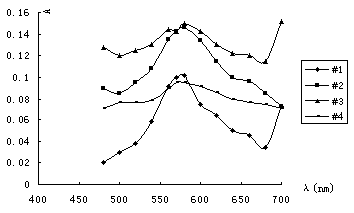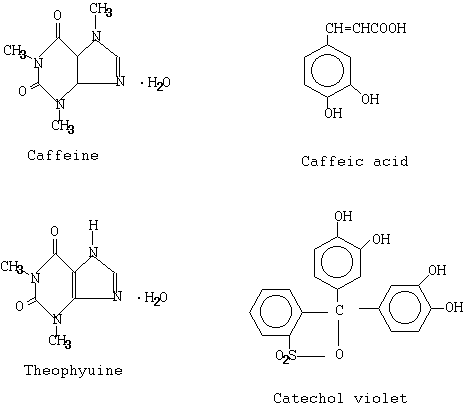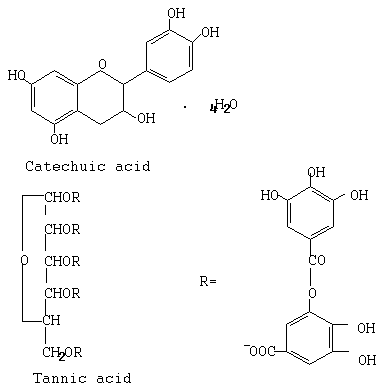http://www.chemistrymag.org/cji/2003/057059le.htm |
Jul. 1, 2003 Vol.5 No.7 P.59 Copyright |
Liu Yun
(Chemical and Environmental Engineering School,Beijing Technology and Business
University, Beijing, 100037, China)
Received on Mar. 16, 2003; Supported by China National Natural Science Foundation (No.20276002)
Abstracts After investigation over 20
brands of laundry detergents made in China and in the United States it has been
surprisingly found that there is a "black area" in laundry. That means that when
temperature is not high enough general commercial detergents have negative effect to
non-fat soils---typically coffee and tea soils. For bleaching system-containing
detergents, if their oxidation ability is not high enough to oxidize the dye soils to
colorless pieces they may lead the soils into half oxidation, and make dye's color deeper and the clothes more soiled.
Keywords laundry, non-fat soils, black area
In a broad significance, the fundamental
improvement in base levels of cleanliness and hygiene has certainly done more to improve
health and increase life expectancy than any single advance in nutrition or medicine.
The development of detergents has two characteristics: 1.rapidity; 2 no
balance. Up to now a large amount of labor has been still put in boring washing, and a lot
of fiber and surface can not be cleaned up, and many types of soils can not be removed
completely. Also there are a lot of work needed to be done in extending the life of cloth
and fiber, and letting washing easier and simpler[1-3].
The vast majority of surfactants, bleaching agents and activators,
optical brighteners, enzymes and non-phosphate builders, and some multifunctional raw
materials, such as polymers, anti-redeposition agents, dye transfer inhibitors, soil
release, even some cationic surfactants, etc. have been used in detergents to improve the
performance. With entering into 21st century and promoting of competition of
the companies of all over the world, detergent industry has become more and more
prosperous and the products have got more innovative [4-8].
In actual practice, we have found a surprising phenomenon in
laundry when the temperature is not high enough, general commercial detergents have
negative effect to non-fat soils--typically coffee and tea soils. Even for some detergents
containing oxygen-containing oxidant system (green to environment, no deleterious to
fiber, color, and FWA, compared to chlorine containing bleaching system), at low
temperature they may also make dye's color deeper and
the clothes more soiled. We suggest such phenomenon as a "black area" in
laundry.
1.1 Materials and apparatus
All the commercial detergents were bought from Beijing local supermarkets and the supermarkets of New York. They are the main types of the detergents in the market. The oil dyed-control clothes were from China Institute of Daily-used Chemical Products. Coffee and tea were all food graded from local supermarkets.
Methene blue (CP, Beijing Chemical Agent Factory) was from a local chemical store. NOBS (nonanoyloxybenzen sulfonic acid), BOBS (benzoyloxy sulfonic acid), BOSM (benzoyloxy succinimide), TAED (N,N,N',N'-tetraacetylethylenediamine), and the other bleaching activator were synthesized in our lab.
The evaluation of performance program was done on QW-1 bottle type washer (made by China Institute of Daily-used Chemical Products), WSP-III whiteness meter( made by Beijing Kangguang Apparatus Manufactory), and 721 spectrophotometer(made by China Shanghai Spectrometer Factory).
1.2 Procedure
Coffee and tea cloth dyeing Cloth was cut into the pieces of 4¡Á4 cm2, and put into 2.5%(w/w) coffee or tea solution. After the solution boiled for 2.5h the pieces were taken out and naturally dried at room temperature, and aged for 3 days before putting into use.
Laundry performance evaluations Laundry performance evaluations were done according to GB13171-97 (Chinese national standard of evaluation of detergents except washing time and temperature), sometimes through dipping in washing liquor before determination.
2 RESULTLTS AND DISCUSSION
2.1 Visual observation
When the oily soil clothes were used to value detergents, the more black the remained
washing solutions were, the cleaner the tested clothes were. But it was surprisingly found
out with non-oil soil that the remained washing solutions had the same color degree with
that of the clothes in the liquor.
Most of the brands of the commercial detergents have negative effects
to coffee or tea soils, the worse to tea soil at lower temperature. With visual
observation the tested cloth was obvious to appear more soiled than before washing. For
the most commercial detergent solution containing methene blue dye the color became
heavier than before washing.
For the composition containing percarbonate and some certain bleaching
activators the color degree of the solution were as the same as the clothes in the
solution. For the composition containing percarbonate, perborate only,and the composition
of N,N,N',N'-tetraacetylethylenediamine(TAED) or the sodium salt of nonanoyloxybenzen
sulfonic acid(NOBS) with percarbonate, the solution especially appeared deeper color than
before washing.
2.2 Evaluation from whiteness change
Evaluation of the performance of 20 commercial detergents from the supermarkets and some
detergent compositions can be seen from Table 1 and Table 2.
Table 1 The efficiency of commercial detergents
Commercial detergents |
Efficiency of soil removed, 5ºC |
||||
No. |
Brands |
Tea soil |
Coffee soil |
||
DWr |
% |
DWr |
% |
||
1 |
JZH |
-1.17 |
-2.1 |
-0.55 |
-1.0 |
2 |
JYU |
-1.34 |
-2.4 |
-0.45 |
-0.8 |
3 |
BZHUN |
-0.97 |
-1.7 |
-0.57 |
-1.0 |
4 |
XMAO |
-2.08 |
-3.7 |
-0.98 |
-1.6 |
5 |
BLANG |
-1.12 |
-2.0 |
0.29 |
0.5 |
6 |
HLI |
-0.71 |
-1.3 |
-0.28 |
-0.36 |
7 |
QQIANG |
-1.78 |
-3.2 |
-0.34 |
-0.6 |
8 |
LWA |
-1.48 |
-2.6 |
-0.03 |
-0.05 |
9 |
LWAY |
-1.05 |
-1.9 |
-0.05 |
-0.09 |
10 |
QSHOU |
-1.65 |
-2.9 |
0.63 |
-1.2 |
11 |
AMIAO |
-1.04 |
-1.86 |
-0.30 |
-0.54 |
12 |
Y4 |
-1.80 |
-3.2 |
-0.72 |
-1.3 |
13 |
JZHC1 |
-0.90 |
-1.6 |
-0.10 |
-0.18 |
14 |
JZHC2 |
-1.32 |
-2.4 |
-0.57 |
-0.10 |
15 |
DPAI |
-0.83 |
-1.5 |
-0.08 |
--0.14 |
16 |
TZI |
-0.53 |
-0.9 |
-0.27 |
-0.48 |
17 |
Zero |
-0.84 |
-1.4 |
||
18 |
Tize |
-0.67 |
-1.1 |
||
19 |
Ultra |
-0.71 |
-1.1 |
||
20 |
Sun Light |
-0.67 |
-1.1 |
||
- The original whiteness(Wr) of cloth:78.1
- The whiteness(Wr) before washing: 21.5-24.5
- The concentration of the detergents were 0.2%;time: 1h
Table 2 the effect of control detergent and its additives to tea soil*
No. |
1 |
2 |
3 |
4 |
5 |
6 |
DWr |
-1.24 |
-0.60 |
-1.28 |
-0.46 |
-0.05 |
-0.96 |
The rate of removing soil, % |
-2.2 |
-1.10 |
-2.3 |
-0.36 |
-0.09 |
-1.75 |
*1 the composition of control
detergent(%,w/w): LAS 10; AEO9 5; Na2CO3 5; STPP 18; CMC
1; Na2SO4 49; Na2SiO4 5; FWA(CBS) 0.1; H2O
5
*2 the concentration of the detergents: 0.2%
*3 the base of all the compositions was control detergent; the additives were
No.1 . 30% percarbonate;
No.2. 21% percarbonate and 9% NOBS;
No.3. 100% control detergent;
No.4. 21% percarbonate and 9% BOBS;
No.5. 21% percarbonate and 9% BOSM(benzoyloxy succinimide);
No.6. 21% percarbonate and 9% TAED;
*4 the whiteness(Wr) of undyed cloth is 78.1; the whiteness(Wr) of dyed cloth is
22.8-25.5.
2.3 Evaluation by the determination with spectrophotometer
The absorption spectrum of dye methylene blue in some detergent composition is shown as in
Figure 1.
Table 3 The absorbance in Figure 1
1 |
2 |
3 |
4 |
||||
l(nm) |
A |
l(nm) |
A |
l(nm) |
A |
l(nm) |
A |
700 |
0.072 |
700 |
0.072 |
700 |
0.152 |
700 |
0.070 |
680 |
0.034 |
680 |
0.085 |
680 |
0.115 |
680 |
0.074 |
660 |
0.045 |
660 |
0.096 |
660 |
0.120 |
660 |
0.076 |
640 |
0.050 |
640 |
0.100 |
640 |
0.122 |
640 |
0.080 |
620 |
0.064 |
620 |
0.115 |
620 |
0.130 |
620 |
0.086 |
600 |
0.074 |
600 |
0.134 |
600 |
0.142 |
600 |
0.092 |
580 |
0.102 |
580 |
0.146 |
580 |
0.150 |
580 |
0.095 |
570 |
0.100 |
570 |
0.142 |
570 |
0.142 |
570 |
0.095 |
560 |
0.092 |
560 |
0.135 |
560 |
0.144 |
560 |
0.090 |
540 |
0.058 |
540 |
0.108 |
540 |
0.130 |
540 |
0.078 |
520 |
0.038 |
520 |
0.095 |
520 |
0.125 |
520 |
0.076 |
500 |
0.030 |
500 |
0.085 |
500 |
0.120 |
500 |
0.076 |
480 |
0.020 |
480 |
0.090 |
480 |
0.125 |
480 |
0.070 |

Figure 1 Absorption spectrum of methylene blue in some
detergent composition (5ºC, 1h dipped in the washing liqour)
The compositions: #1) 0.1% percarbonate in
0.03% sodium silicate; #2) 0.1% percarbonate and 0.04% perorganic acid in 0.03% sodium
silicate;
#3) 0.1% percarbonate and 0.04% BOBS in 0.03% sodium silicate; #4) 0.03% sodium silicate
solution
There are some chemical structure of the
major components of coffee and tea in Figure 2. These compounds are known as the source of
color of coffee and tea and as the typical materials for non-fat soils.
These compounds are all N-containing or polyphenols, which are easily
oxidized in suitable conditions. There is a sudden rising after 670nm for No 1 and No 3.
It is obvious that the higher absorption is the main reason of to deeper color change.
That means that half oxidation has not good effect to laundry. Percarbonate, or
percarbonate with bleaching activator Benzoyloxy benzensulfonate or the like are not good
enough to oxidize the compounds at that temperature and that concentration.
Also there are some N-containing and polyphenol polymers and some
polydouble bond polymers in the coffee and tea soils, which have higher melting points.
When being washed with general detergents under lower temperature, the dyes cannot be
dissolved and softened. In addition when the brightness of soil surface are lost by
scrabbing of clothes themselves and the detergent ingredients the color of soils may
become deeper. Also it is conferred that if the polyphenols only become sodium salts but
are not enough oxidized and cleaned out the washing will give negative effect.


Figure 2 the chemical structure of some
major components from coffee and tea
It has been surprisingly found that there is a "black area" in laundry (the writer suggests). That means that when temperature is not high enough general commercial detergents in China and in the United states have negative effect to non-fat soils---typically coffee and tea soils. Some bleaching system-containing detergents, even when some bleaching activators added, if their oxidation ability is not high enough to oxidize the dye soils to colorless pieces they may also make dye's color deeper and the clothes more soiled.
REFERENCES
[1] Niall Fitzgerald. Proceedings of the 4th world conference on detergents:
strategies for the 21st century, AOCS Press, Champaign, Illinois, US, 1998:1-6.
[2] Liu Y. Detergents---Principle. Materials. Processing. Composition
(Xidiji---yuanli,yuanliao,gongyi,peifang). Beijing: Chemical Industion Press (Huaxue
Gongye Chubanshe),1998.
[3] Liu Y. Detergents & Cosmetics (Riyong Huaxuepin Kexue), 2000, 23 (1+): 146-150.
[4] Susan Judith Mason, Whitley Bay, Ludivine Pascale Gripppay et al. US 6 444 634 B1,
2002.
[5] Liu Y, Ji R Y, Zhang J. Proceedings of the 4th world conference on detergents:
Strategies for the 21st century, AOCS Press, Champaign, Illinois, US, 1998:238-241.
[6] D Martin Davies, Steven J Foggo, Paul M Paradis. J.Chem. Soc., Perkin Trans 2, 1998:
1381-1383.
[7] Uri Zoller. Handbook of Detergents. Marcel Dekker, Inc., New York. Basel, 1999.
[8] Wu S G, Shi Q Q, Zheng Y. Proceedings of 7th international conference on surfactants
and detergents, 2002: 61-66.